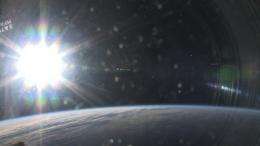More than two million first orbits

Since its release on 12 April, the film recreating Yuri Gagarin’s pioneering flight has been seen almost 2.6 million times. Much of the footage was shot aboard the Space Station by ESA astronaut Paolo Nespoli.
The first human spaceflight on 12 April 1961 lasted only 108 minutes. During this time Yuri Gagarin flew in his Vostok-1 spacecraft once around the globe, becoming the first human to see the view from space: bright stars in a carbon-black sky, a shiny Sun and the majestic Earth.
Seeing the home planet below his craft was perhaps the most stunning experience of his flight. Mixing old footage and audio recordings from the mission with fresh material shot from the International Space Station, First Orbit recreates the views that Gagarin enjoyed as accurately as possible.
Simple idea, but difficult to realize
"When Gagarin came back from space, everyone wanted to know what it was like," says director Christopher Riley, who conceived First Orbit.
"Part of what people meant by that question was: what did Earth look like from up there? And that was something only Gagarin would really ever know."
He wanted to reconstruct the whole ride aboard Vostok-1 – and ESA agreed to help him. Together with Gerald Ziegler, Flight Dynamics Engineer working at ESA's Space Operations Center, they calculated when the Space Station was exactly above the path of Gagarin’s flight at the same time of day.
The lighting conditions and everything else had to be as close as possible to what Gagarin would have seen starting from launch near the Aral Sea, at 06:07 GMT, and on into the night side of Earth over the Pacific Ocean, before emerging into sunlight again over the Southern Atlantic and passing across the whole African continent and the Middle East, returning to the ground at 07:55 GMT, just north of the Caspian Sea.
With Roland Luettgens and Giovanni Gravili of ESA, Gerald and Christopher managed to find some indications from Gagarin’s notes about the viewing angles and details he saw, and all these were sent to the Space Station crew.
Christopher didn’t want to use satellite images because the footage shot by humans – with errors and imperfections – is more authentic.
Paolo as cameraman
ESA helped to fit the requests into the crew time on the Station and, after a test shoot last November by NASA astronaut Doug Wheelock, ESA’s Paolo Nespoli filmed most of the footage for the project in early January.
Paolo never appears in the film himself, but as the Space Station flies into the night side of Earth over the north Pacific you can catch a glimpse of him reflected in the window as he floats towards the camera.
There is one difference between First Orbit and Gagarin’s actual flight: the Moon.
"When Gagarin flew into the night side of Earth on 12 April 1961, it was a crescent Moon," explained Christopher.
“According to his autobiography Road to the Stars, he tried to look for the Moon out of curiosity, but unfortunately it was not in his field of view. 'Never mind,' he wrote, 'I'll see it next time.'”
For Gagarin, there was unfortunately no next time, but Christopher added the Moon to the film.
“Paolo has not yet seen the film, but is more than curious to see as soon as he returns,” says Roland Luettgens, who is working as ESA Mission Director at the Columbus Control Centre and has told Paolo all about the film’s success.
“He is happy having been able to participate and sends many greetings to all who supported making the film.”
The film is freely viewable on www.firstorbit.org and on YouTube. During the first week since it went online, it has been seen almost 2.6 million times.
Provided by European Space Agency



















